TATORTs. TV Ratings. Quota for Women Off-Screen.
Today I am looking at the 36 new episodes of German Top Cop Drama TATORT in 2020, comparing the shares of men and women in the 6-departments-check (direction, screenplay, camera, sound, editing and music), and analyzing the development from 2011 to 20. In addition, I will check how these films fare under the “2 from 6” departments rule. Finally, I will discuss the TATORTs in respect to the TV ratings and a female quota, with a short detour to the demands set up by Pro Quote Bühne (Pro Quota Stage).
The 6-Departments-Check 2020
It was already apparent during the summer break that 2020 was going to be a very good year for female TATORT directors, with a total of 16 of the 36 TATORTs coming in at 44.4 %. At the other end are the female sound recordists, or not, they were not engaged for TATORTs for the third year in a row. Whereby this is not quite true, the highest proportion of women is once again achieved in the average, this time with 77.3 % female editors. For comparison: Alumni 51:49, Crew United database 35.5 : 64.5.
What about the problem child scriptwriting?
Has the women writers’ initiative Tatort: Drehbuch – which called for a 50 % quota of women writers by 2021 – brought about a turnaround, away from the stifling male bias? I’m afraid it hasn’t. In 2020, women make up 17% of the 36 TATORT scripts. This figure means that among all the authors of the 36 scripts, 17 % are women. (See also “Why aren’t you working with female scriptwriters?”).
Incidentally, the proportion of women screenwriters (17%) is at a similar level to that of women cinematographers in TATORTs (16.2%), and this despite the fact that the proportion of women graduates in screenwriting (48%) is almost twice as high as that in cinematography (25%). Similarly, if the Crew United database is any measure, the proportion of women screenwriters working professionally (42.8%) is almost four times that of women cinematographers (11.2%) (as of 23.10.20, many thanks to Vincent Lutz). How much Female Gaze is possible when more than 80 % of the scripts are written by men and more than 80 % of the filminig is done by men?
The next figure shows the gender composition of the authors in 2020:
There was only one TATORT in 2020 that was not (co-)written by a man: the Black Forest crime scene REBLAND, directed by Nicole Armbruster. In addition, there were 7 TATORTs that were written by man-woman or woman-man teams. Consequently, of all the scripts in which a woman was involved, 12.5 % were written only by women (or in this case by a woman). The situation is different for men: 80 % of the scripts with male participation were written by men only: 15 by one author, 1 by a duo: ZÜRI BRÄNNT, written by Lorenz Langenegger and Stefan Brunner. This TATORT is he first case of the new Zurich team with two female investigators, Isabelle Grandjean and Tessa Ott. It seems an opportunity missed when the characters and their entire environment were created without the involvement of a female writer, but that is a topic for another day.
Why are so many male-written crime stories still being filmed, why so few by female authors? Scriptwriter and co-signatory of the Tatort:Drehbuch Open Letter, Meike Hauck tried to explain the behaviour of those responsible for this disparity with the term “risk aversion” (source DLF Kultur interview), who say it is partly due to quality – but perhaps it is also a question of secret female author aversion.
Why are so many women allowed to edit TATORTs but not to write or film it? Are women better at editing, or are the wages significantly lower than for feature films – where the proportion of male editors is much higher – are there stricter guidelines, or what might be the reasons?
Polizeiruf 110 (the other top cop drama on Sunday nights)
For the sake of completeness regarding the Sunday evening 8.15 p.m. slot, I would like to mention the POLIZEIRUF films. Six were broadcast in 2020, three from Magdeburg, two from Rostock and one from the German-Polish border area. One was directed by a woman, Brigitte Maria Bertele: DER VERURTEILTE, she worked with one (the only) female DoP, Jana Lämmerer. All six scripts were written by men – 4 times alone, once in pairs, once it were three. There were only male composers and sound mixers. Only in editing do we find a female majority, five women and one man (Horst Reiter, TOTES RENNEN) edited the six films.
Development of Six TATORT Departments 2011 to 2020
Here are the 10 years figures for the six departments:
Since the 10-year overview is a bit crowded, I have shown the development of the six trades individually below. We see the increase in the proportion of female directors, presumably triggered by the targets (Degeto originally specified 20%, which has been achieved since 2018), the high proportion of female editors over the years and, well, the values for the other four department. Just as a reminder, the alumni female percentages: Women directors 44%, women scriptwriters 48%, women cinematographers 25%, women sound engineers 11%, women editors 51%, women composers n/a.
What about the TV Ratings?
TATORTE are the TV films with the highest ratings in Germany. Among the top 32 in 2020 were 26 TATORTs and six POLIZEIRUFs. The two highest ranked were TATORTs from Münster, in 3rd and 4th place there are two TATORTs from Cologne, in 1st and 3rd place episodes directed by women. All of them were written by male authors.
The Münster TATORT (which, by the way, is mostly filmed in Cologne) is always in first place in the ratings; it probably doesn’t matter at all whether a woman is behind the directing or the script, people tune in because of the two main characters, how they were originally developed by Stefan Cantz and Jan Hinter in 2002 and have since been interpreted by the actors Axel Prahl and Jan Josef Liefers. Whoever tunes in to Münster wants to see the Münster duo. No matter who directs or wrote the script, I suppose absolute no-names could be cast as the episode leads, that wouldn’t hurt the ratings.
I am generally sceptical about these ratings (see also For Heaven’s Sake, look at the Ratings!), and indeed, what does it mean that extrapolated 6 or 9 or 12 million people tuned in to a television event? Actually only just that, that they had tuned in. Perhaps you can also deduce that there was a lot of advertising for the film or that advertising is no longer necessary because there is a large regular audience for the slot or the format. Every evening at 8 p.m. there’s the Tagesschau ( news, and on Sundays at 8.15 p.m. there’s usually a TATORT. I would know if it’s my favourite TATORT team – if I have one – or maybe I just watch all the episodes, and a lot of people already do. To stick with the above example: even if a Münster TATORT is really bad with an unmotivated plot, blurred camera sequences and bad sound, it will still end up in the top 3 in a year and the Münster cases will be there again the following year.
Back to female scriptwriters, why is their share so low? Is anyone in a position of responsibility seriously afraid that TATORT will be watched less, or not at all, if not just one, but many scripts are written exclusively by women? Or that the product TATORT will become worse? I dare say: not worse, but perhaps different. But we don’t know that, because that has never been the case. – All right, I’ve only analysed the data from 2011 onwards, but I strongly assume that in the decades before that there was never a share of women of 50 % or more for the scripts either.
So maybe we should give it a go. You’ve been focusing on directing for a while now, and now it’s time to tackle other departments. So make it clear now that in 2022 at least 50 % of the scripts must be written by women writers only – individually or as a team. And then we’ll meet again at the beginning of 2023 and see whether or how this has had a positive or negative effect. If you want to be really daring: in 2023, broadcast ONLY TATORT scripts by female writers. Why not? ARD is public television, so it is not financed by advertising but by fees. And actually – I repeat myself – obliged to the German Constitution and Basic Law.
And if you really believe that TATORT scripts by women are of inferior quality to those by men, maybe it’s not about better or worse but simply about a different quality. Maybe you are just so used to reading male gaze material that something clearly different seems inferior to you. If it’s not that, then talk to film schools and find out if aspiring female writers are being trained in any way inferior. If that’s not it either, I can’t think of any more reasons off the top of my head why there should be significantly fewer films based on scripts by women shown on public TV.
Is it Possible to Combine Quotas for Women?
The question is, of course, what will happen if the broadcasters suddenly concentrate on a quota for female authors. Will women cinematographers, sound mixers and composers remain underrepresented? How will the numbers for women directors change? The art, the challenge or simply the need of the hour should be to end the under-representation of women in several positions at the same time.
Pro Quote Bühne / Pro Quota Stage
The lobby group Pro Quote Bühne recently drew up a manifesto which states, among other things:
We demand a 50% women* quota in all artistic stage departments!
German theatre likes to claim that it is socially critical and innovative, that it identifies grievances and holds up a mirror to society. But behind the stage, this apparatus is largely closed and uncritical of its own power structures. Such theatre is in a rigid, stereotypical state.
We want a theatre that reflects the concerns of all people!
A theatre that lives equality and addresses and questions the diversity of social role models!
If half of the people who work artistically and thus also shape our society are relegated to sideshows and kept down, this also reduces the potential of ideas, voices and perspectives and creative forces by half!
A 50 % women’s quota for all artistic professions and for staged plays. This can be achieved relatively easily, for example, at a city or state theatre, at private or touring theatres with well-planned seasons, given good will. The theatre management decides on the plays for the new season and can ensure that there are an equal number of plays by playwrights. In addition, the number of roles and also the approximate amount of text could be roughly estimated. The staffing policy at the theatre – how many festivals and how many guest directors, scenic and costume designers, musicians, etc. – can be based on parity.
This may not happen overnight – sometimes there are already long-term agreements – but basically it is relatively feasible. (However, I don’t know what the requirement is for artistic positions with a strong female bias, such as costume design – at least 50 % women or 50:50?).
Applying the Concept “2 of 6”
This is much more difficult with film and television productions. Let’s stay with the example of TATORTs. There is not one responsible person or group that decides on all 36 TATORS 2020, on the material, on the teams and on the cast. There are different regional broadcasters, editorial teams, production companies – and at the time a production begins, the broadcast date is usually not yet fixed. That means there is not one person who can cook the recipe – so-and-so many % women in so-and-so many trades in one year.
It seems to work to some extent if the recipe consists of only one ingredient – as the development of the proportion of female TATORT directors has shown. Presumably it was repeatedly pointed out from above that women directors should be engaged, perhaps contacts were made, names were mentioned. And so the target of 20 % was reached for the first time and clearly exceeded in 2020 – perhaps the 40 or even 50 % mark had already been targeted internally, I don’t know. Certain TATORS are still without a director, but that is a topic for another day).
I also haven’t heard any suggestions as to how – let’s stick to the departments in question – six quotas should be reconciled, and I’m also not sure if those who demand women’s quotas for their department or for all – for example Pro Quote Film – call for 50 % in each case. And does that mean at least 50% women, or 50:50 – and what would happen on average then?
Be that as it may, I have long since proposed a small, easily implementable approach, #2v6pN – 2 out of 6 plus NEROPA. This means that every production (that receives public money, that is supervised by an editorial team, that is planned by a production company) must ensure female participation in at least two of the six trades of direction, script, camera, sound, editing and music. So, for example, a woman cinematographer and a woman-man composition duo. Or a woman director and a woman editor. Or a female writer, a female sound editor and a female editor, because there can be more than two of course.
The advantage is obvious: every production has to do something, every production can and must increase the proportion of women. No one has to juggle from the outside (“There are already 20 TATORTs planned with cameramen, how do I persuade x productions to hire camerawomen?” in order to achieve a quota of camerawomen, for example).
The next figure shows how many TATORTs (in %) would have met or not met the #2of6 demand in 2011 to 2020 – yes, that is the vast majority:
2020 is the highest, but don’t be fooled, 50% is not the target line here, it’s 100%. All films should involve women in at least two of the six trades.
What can be said against this proposal? A sound engineer friend of mine said that then all productions will take women directors and scriptwriters, and the others – including sound – will go empty-handed. I think that is very unlikely. An increase from 7 to 36 scripts with a (co-)writer would be great, but without compulsion (“You may only take female writers”) absolutely unlikely. The same goes for directing. I’m also curious right now whether the 40 % quota for female directors will be cracked again in 2021, I dare to doubt that for various reasons, but that’s not the issue right now. But what speaks against this really simple to implement and effective approach: well, the simplicity, or let’s say that it is only a piecemeal solution, not a permanent one. And it is not supposed to be. It is, after all, a transitional proposal to bring about rapid change. Namely, more women in the six trades at TATORTEN, and at the same time a rethinking of the productions. As long as not every production is in demand, the Wiesbaden TATORT can continue to be produced by 100% men (referring to these 6 trades), others can have only one female editor but implement an undisturbed male gaze on set.
And why 2 out of 6 and not 3 out of 6? Because the alumni numbers for directing, screenwriting and editing are just below or just above 50% female ratio, but those for camera, sound and music are very much below that. That’s why 2 out of 6 is more appropriate. Besides, that is easier to achieve as a first step. And we all like a sense of achievement.
I think there is a lot to be said for making 2 out of 6 compulsory immediately for all productions that receive public funding – because it is a step towards more gender equality.
Final Thoughts
I have often heard that more women behind the camera will lead to more women in front of the camera. I highly doubt that, because the women in front of the camera – actresses and stuntwomen – are there because their roles are in the script. If there is a woman director, a woman cameraman, a woman sound recordist and an editor behind the camera, but the script is by a man who will not tolerate change, and if NEROPA has not yet been made compulsory (different topic, clearly), then there will be as many or as few women’s roles in the film as if it were a director, a cameraman, a sound recordist and an editor.
A second rumour is that more women directors leads to more women behind the camera. There is some truth in this, the probability that a female director works with a female cinematographer is often higher than that a male director does (I once evaluated this for the top 100 German cinema films, a bit difficult of course because the proportion of female directors was not very high, but the trend is there – and I’ll post the link). But that was cinema, as I said, and that’s another story. I have often noticed in the TATORTEN that a female director does not automatically work with more women in the other 5 trades. This can have many reasons, for example because it’s the first time she’s ever done a TATORT, or because she’s working at a location where certain trades have been in firm hands for ages. Perhaps it is more difficult for some female directors to ask for team women because “we already have a female director”. And of course there are also women directors who have mainly men in their ‘permanent’ team.
If you have any thoughts on this, feel free to post them in the comments below.
For inspiration, here is the 2020 TATORT: You can see the blue columns for films by female directors and the pink columns for those by male directors. The X-axis (that’s the horizontal one, below) is 0 to 4, meaning that of the remaining five trades – script, camera, sound, music and editing – 0 or 1 or 2 or 3 trades have female participation. There were fewer films by women directors. But you can see that films by women directors did not meet the criterion 2of6 more often than films by men directors (that’s scores 2 and 3).

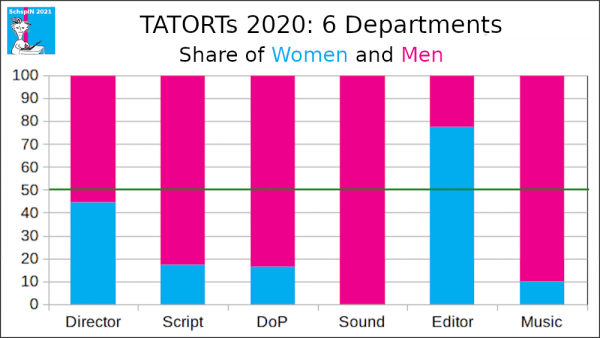
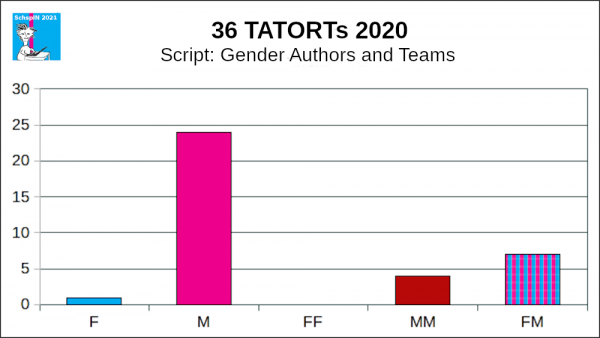
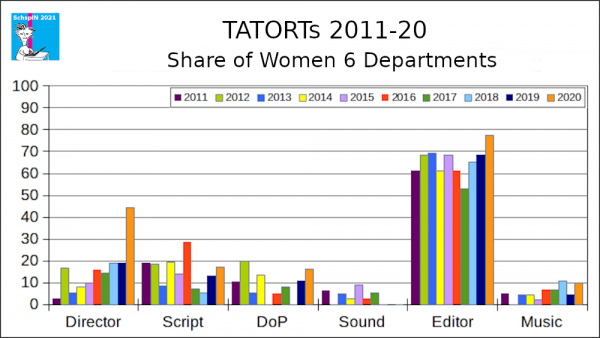
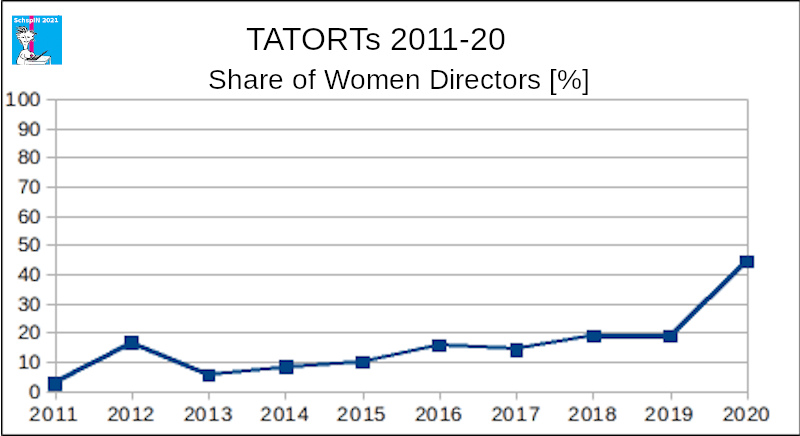
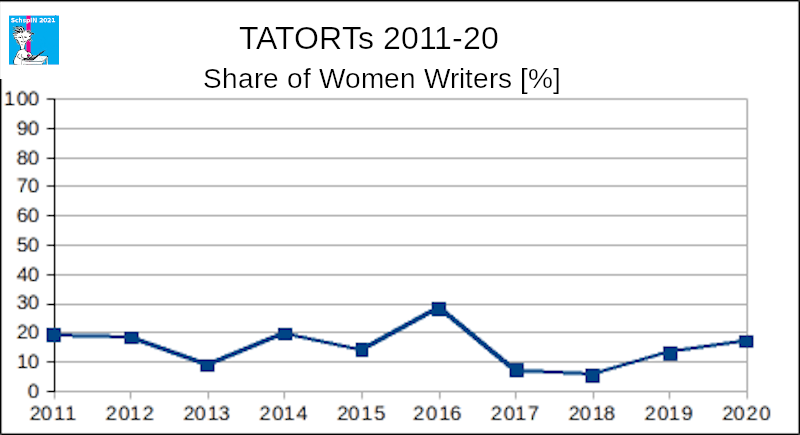
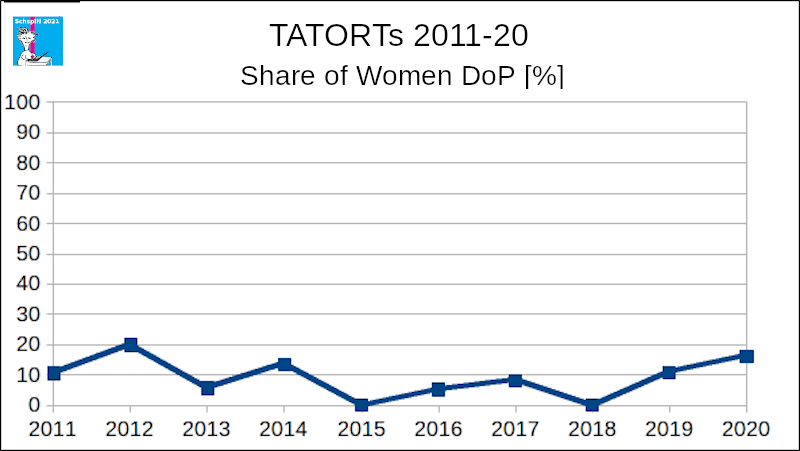

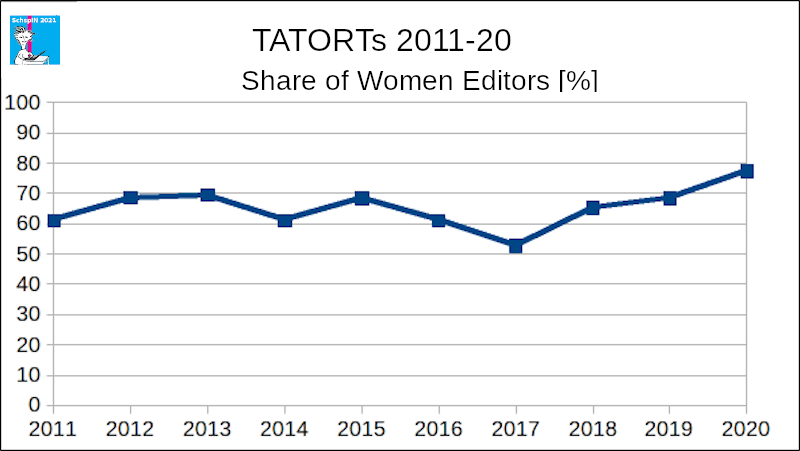
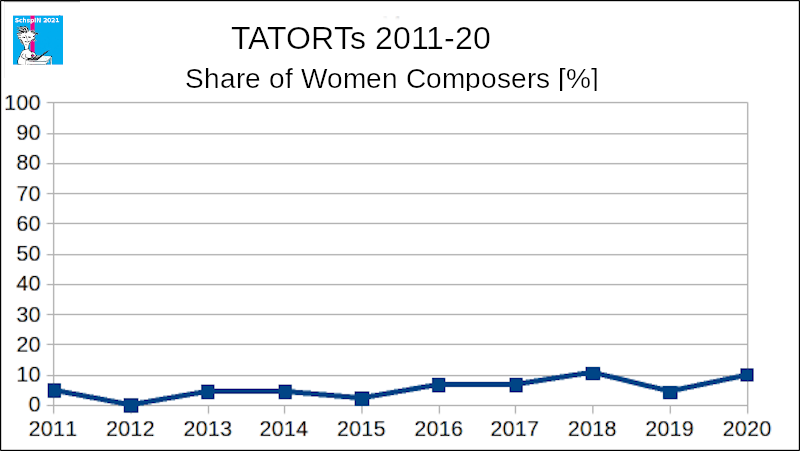
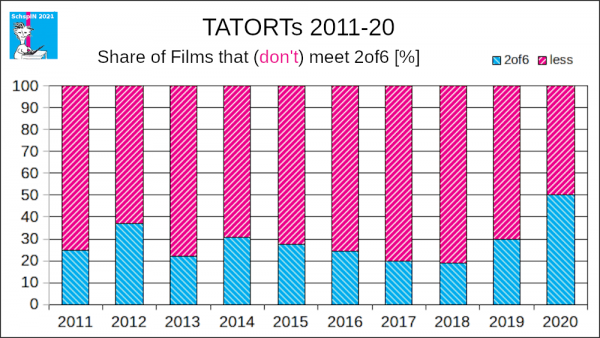
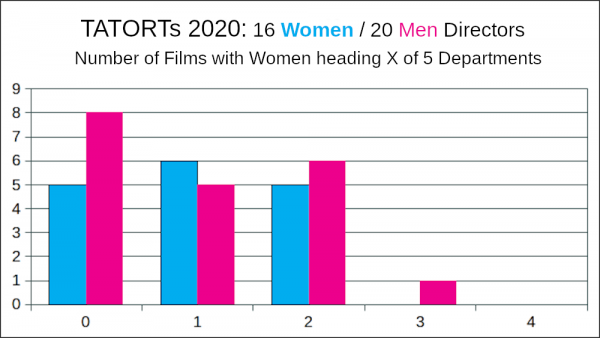
Pingback: Gerechte Teilhabe: Ja es geht. | SchspIN